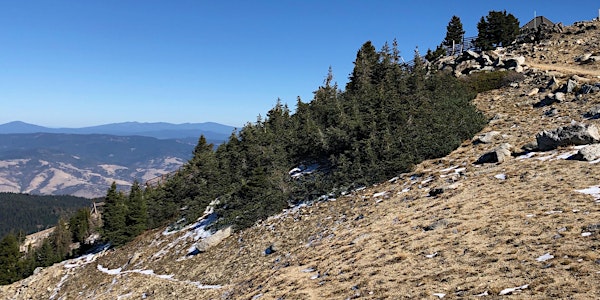

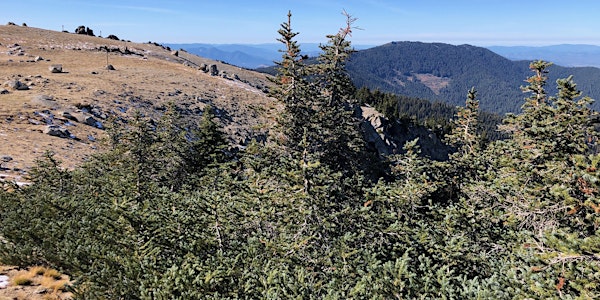
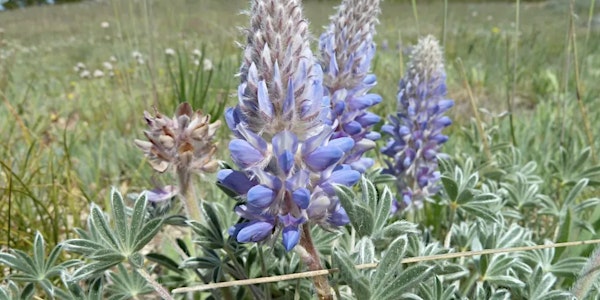
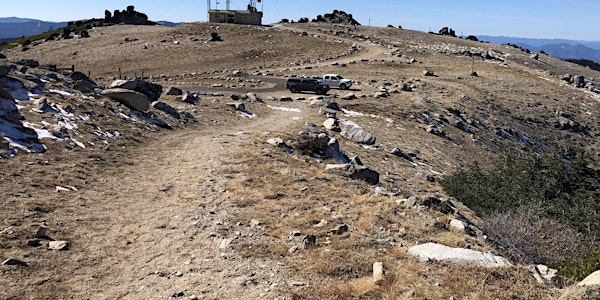
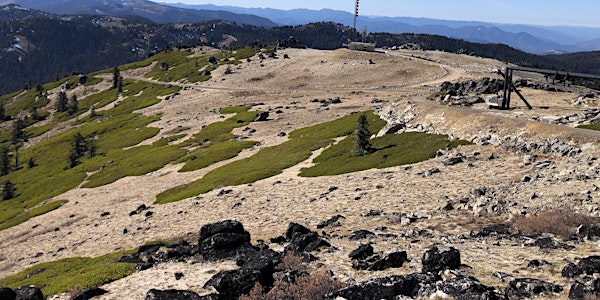

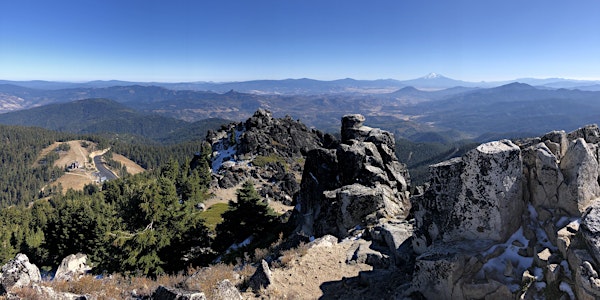
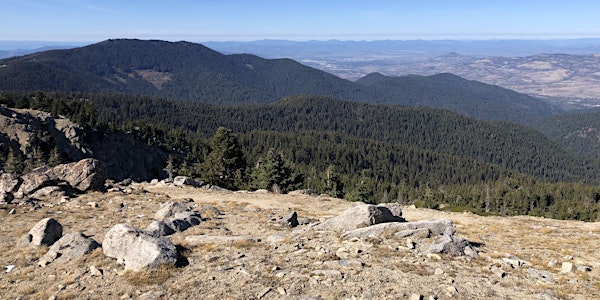
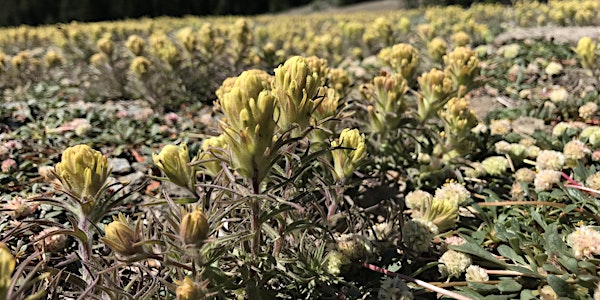
Mt. Ashland
Featured conifers: whitebark pine, Engelmann spruce, subalpine fir, mountain hemlock, Shasta red fir, western white pine, white fir
Date and time
Location
Mt. Ashland Ski Area Overflow Parking Carpool Meetup
11 Mount Ashland Ski Road Ashland, OR 97520Refund Policy
About this event
- 8 hours
Mt. Ashland
Conifer Highlights:
· whitebark pine (Pinus albicaulis)
· Engelmann spruce (Picea engelmannii)
· subalpine fir (Abies lasiocarpa)
· mountain hemlock (Tsuga mertensiana)
· white fir (Abies concolor x Abies grandis) hybrid
· Shasta red fir (Abies x shastensis) hybrid
· western white pine (Pinus monticola)
Some other cool species we might encounter along the way: Mt. Ashland lupine, Jaynes canyon buckwheat, Henderson's horkelia, pasqueflower, ballhead ipomopsis, silky raillardella, western hawkweed, cobwebby paintbrush, cutleaf fleabane, lanceleaf stonecrop, Davidson's penstemon, sulphur flower buckwheat, coyote mint, spreading phlox, dusty maidens, rosy pussytoes, pussypaws, and more!
Leaders: Luke Ruediger & Suzie Savoie, with guest botanist Julie Kierstead
About Julie Kierstead:
Julie Kierstead has been working as a botanist since 1976, doing rare plant surveys and conservation work in Oregon and California. She has a B.S. in botany from Oregon State University and an M.S. in biology from Northern Arizona University. She worked for the Berry Botanic Garden in Portland as conservation director, developing a seed bank for rare and endangered plants of the Pacific Northwest and helped get a state endangered species act passed in Oregon. Since 1989 she had the good fortune to serve as Forest Botanist for the Shasta-Trinity National Forest in northwestern California, where she was ideally situated to promote plant exploration in the Klamath Ranges and southern Cascades. She retired in 2019 and currently lives in Ashland, Oregon.
Brief Trip Description:
From the Mt. Ashland Ski Area overflow parking area, we will briefly stop at the Mt. Ashland Campground for a quick use of the pit toilets if needed. We will carpool up to the top of Mt. Ashland to look at the subalpine fir near the top, and take a short off-trail into the bowl on the north side of the summit to view the whitebark pine. While on the peak we will view and discuss other conifers and flora. We will then drive down to the Rabbit Ears parking area. From Rabbit Ears there will be two options for the remainder of the day:
Option 1) Botanize with Julie Kierstead around Rabbit Ears on more gentle terrain.
Option 2) Hike off-trail with Luke and Suzie, down to see the Engelmann spruce and other conifers and flora of the area, off-trail on steep slopes, and then hike back up to Rabbit Ears.
More Information:
Mt. Ashland is the tallest and likely the most well-known mountain in the Siskiyous. It is visible from I-5, the site of the Mt. Ashland Ski Area, and the source of drinking water for the small town of Ashland located at its base. It is easily accessible by the scenic backcountry route, Forest Service Road 20 and contains outstanding botanical values, including rare conifer species, diverse flowering plant species, extensive sagebrush habitats, subalpine wetlands, meadows, and glades. The flora includes the Mt. Ashland lupine (Lupinus aridus ssp. ashlandensis) which is found only on Mt. Ashland, a number of other narrow Klamath-Siskiyou endemics, and colorful floral displays. Mt. Ashland is accessible by Forest Service Road 20, the Mt. Ashland Summit Road, the PCT and various trails connecting into the Ashland Watershed. Large portions of Mt. Ashland are protected in Botanical Areas on both the Klamath National Forest and Rogue River-Siskiyou National Forest.
Mt. Ashland-Siskiyou Peak Botanical Area information:
https://www.fs.usda.gov/wildflowers/regions/Pacific_Southwest/MtAshlandSiskiyouPeak/index.shtml
Mt. Ashland-Siskiyou Peak Botanical Area Species List on Oregonflora:
https://oregonflora.org/ident/key.php?cl=23&proj=2&taxon=All+Species
Carpool Meetup Location and Time:
9am
Mt. Ashland Ski Area overflow parking lot
(Please arrive five minutes early)
If you register and are interested in carpooling from Ashland, we might be able to help make carpool arrangements from Ashland. Please email info@applegatesiskiyou.org for carpool arrangmenets.
Expected return time: 5pm or before
Drive Time from Ashland to Mt. Ashland Ski Area overflow parking: 35 minutes
Driving Directions from Ashland to Mt. Ashland Ski Area overflow parking:
Take I-5 south 8.6 miles to exit 6, Old Highway 99, towards Mt. Ashland. In .9 miles turn right onto Mt. Ashland Ski Rd. After 9 miles you will pass the Mt. Ashland Ski Area. Drive just beyond the main parking for the ski area, and you will see a wide, paved parking area, just before the road turns to dirt. Park here, in the overflow parking, beyond the main ski area parking lot, right at the beginning of Forest Service Road 20.
Driving Directions from the Mt. Ashland Ski Area overflow parking lot to the top of Mt. Ashland: From the carpool meetup, continue along the road. The road will turn to dirt where the road turns into Forest Service Road 20. Drive another mile or so on the dirt road, passing by the Mt. Ashland Campground. After the campground stay to the right at the intersection with Road 20 and Road 300 that goes to the top. Drive Road 300 to the top of Mt. Ashland and park in the parking.
Difficulty: Moderate at the top of Mt. Ashland to see the whitebark pine and subalpine fir.
(Optional) The optional off-trail to see the Engelmann spruce is a very difficult off-trail hike.
Distance: approximately .25 miles of walking on uneven terrain at the top of Mt. Ashland to see the whitebark pine and subalpine fir, some of it off-trail and steep.
(Optional) It is approximately 3 miles off trail to see the Engelmann spruce, with about 1.5 miles down and 1.5 miles back up.
Elevation: Top of Mt. Ashland is at 7,532 ft.
Approximate elevation gain: There won't be much significant elevation gain or loss while on the top of Mt. Ashland to see the subalpine fir, but it isn't flat. There is rocky terrain to navigate with some slight inclines. A little off-trail downslope will be needed to see the whitebark pine, along with some elevation gain and loss.
(Optional) 900 ft. elevation drop, and then gain to climb back out, to see the Engelmann spruce off-trail. Starting at 6,900 ft., and dropping to 6,000 ft. and climbing back up.
Group Size Limit: 25
Appropriate Footwear and Gear: Sturdy footwear is recommended, and trekking poles if they are helpful for you.
Bring with you: Lunch, snacks, water, sun protection, layers, binoculars, camera, hand lens, and any other personal items you might need.
Special Considerations: There are pit toilets at the Mt. Ashland Campground only. There are no bathrooms after that. Be prepared to go to the bathroom in the woods. Cell phone reception may be spotty on this field trip.
Photo below: Julie Kierstead